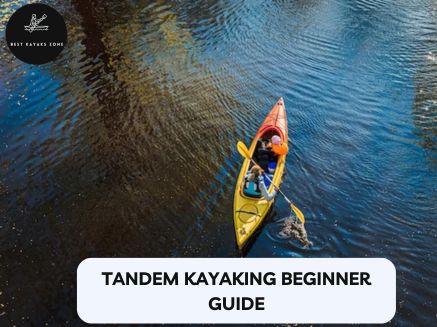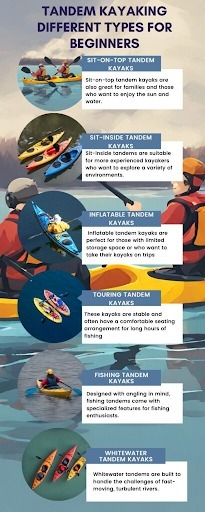Are you excited about delving into the world of tandem kayaking? If you’re a newcomer looking for adventure and a unique way to connect with a partner or a friend, you’ve landed in the right spot. Tandem kayaking is an exciting way to go out on the water with a friend and paddle together.
In this guide, we will explain the basics of tandem kayaks, share expert tips, and recommend the best products to help you get started with kayaking.

Tandem kayaking is a thrilling water-based activity that involves two people paddling together in the same kayak. It’s all about teamwork, coordination, and sharing the experience of kayaking on the water. In tandem kayaking, both paddlers work in unison to propel the kayak forward, steer it, and enjoy the journey together.
Exploring Types of Tandem Kayaks: A Comprehensive Guide
Sit-on-Top Tandem Kayaks:
These kayaks are incredibly stable and user-friendly, making them an excellent choice for beginners. They have an open-top design, so you sit on the kayak rather than inside a cockpit. This design allows for easy entry and exit and is ideal for recreational paddling and calm waters. Sit-on-top tandem kayaks are also great for families and those who want to enjoy the sun and water.
Sit-Inside Tandem Kayaks:
Unlike sit-on-top kayaks, these kayaks have an enclosed cockpit, similar to solo touring kayaks. They offer better protection from the elements and can be used in a wider range of conditions, including colder or rougher waters. Sit-inside tandems are suitable for more experienced kayakers who want to explore a variety of environments.
Inflatable Tandem Kayaks:
Inflatable kayaks are known for their portability and ease of storage. Inflatable tandem kayaks are perfect for those with limited storage space or who want to take their kayaks on trips. These kayaks are remarkably stable, and their durability has improved significantly in recent years. They are well-suited for recreational use in calm waters and are generally affordable.

Touring Tandem Kayaks:
Touring tandems are designed for longer journeys and expeditions. They are typically longer and narrower than recreational kayaks, which makes them more efficient in terms of speed and tracking. These kayaks are perfect for exploring large bodies of water, coastal regions, and extended trips. They often come equipped with storage compartments for gear and supplies.
Fishing Tandem Kayaks:
Designed with angling in mind, fishing tandems come with specialized features for fishing enthusiasts. They may have rod holders, fish finders, and ample storage for fishing gear. These kayaks are stable and often have a comfortable seating arrangement for long hours of fishing.
Whitewater Tandem Kayaks:
Whitewater tandems are built to handle the challenges of fast-moving, turbulent rivers. They are typically shorter, highly maneuverable, and built to withstand the rough conditions of whitewater. Paddlers in these kayaks need advanced skills to navigate safely in these environments.
Convertible Tandem Kayaks:
Convertible tandems offer versatility by allowing you to switch between tandem and solo paddling. They come with adjustable seating positions or additional seating options. This flexibility is great for those who want a kayak that can adapt to different scenarios.
Why Choose for Tandem Kayaking?
Before we get into the specifics, let’s explore why tandem kayaking is a great choice, especially for beginners to this exciting activity.
Sharing the Adventure: Tandem kayaking allows you to have an adventure with a partner, which is a great option for couples, friends, and families.
Improved Stability: Tandem kayaks are generally more stable, making them suitable for beginners who may be apprehensive about solo kayaking.
Strength in Numbers: Paddling together provides increased power and speed, making it easier to cover longer distances.
Essential Gear and Safety Tips
Before hitting the water, it’s crucial to understand the gear you’ll need and the safety measures to follow:
Tandem Kayak Selection:
1.Choose the Right Type: Select a tandem kayak that suits your intended use. For calm waters, recreational tandems work well, while touring tandems are better for longer journeys or expeditions.
2.Check Weight Capacity: Ensure the kayak can comfortably hold both paddlers and any gear you plan to bring along. Exceeding weight limits can affect stability.
Tandem kayaking different types for beginners
Look for tandems with ample storage options for your gear and supplies, especially if you’re planning extended trips. Storage hatches and compartments can keep your items secure and dry.
Paddles:
Invest in Quality: Don’t skimp on paddle quality. Invest in durable, lightweight, and appropriately sized paddles. This makes paddling more comfortable and efficient.
Paddle Length: Choose the right paddle length, which should be based on your height and the kayak’s width. A paddle that’s too long or short can lead to fatigue.
Blade Design: Consider the blade design. Wider blades provide more power, while narrower blades are better for speed and efficiency. Select based on your kayaking style and preferences.
Life Jackets:
Safety First: Always wear Coast Guard-approved life jackets when kayaking. Ensure they fit well, offer proper buoyancy, and have convenient features like pockets for small essentials.
Type Matters: Life jackets come in various types; some are designed for specific water activities. Choose one suitable for kayaking to ensure the best protection.
Regular Inspections: Regularly inspect your life jackets for any signs of wear and tear. Replace them if they show any damage to maintain safety on the water.
Roof Racks and Tie-Downs: If transporting the kayak on top of your vehicle, use roof racks designed for kayaks. Follow the manufacturer’s instructions for proper installation. Secure the kayak to the racks using tie-down straps or ropes to ensure safe transit.
By considering these factors and following the proper techniques for inflating, deflating, and transporting your 2-person inflatable kayak, you can have an enjoyable and hassle-free kayaking experience.
Setting Up Your 2-Person Inflatable Kayak:
Safety Precautions:
Capsize Drill: Learn how to safely exit a capsized kayak. Practice this skill in a controlled environment to build confidence and preparedness.
Communication: Establish a clear communication system with your paddling partner. It’s crucial for coordinating strokes and addressing any issues that may arise.
Weather Awareness: Pay close attention to weather forecasts and be cautious when kayaking in adverse conditions. Sudden changes in weather can pose risks, so always be prepared for such situations.
Paddling Techniques : Proper paddling is essential for an enjoyable tandem kayaking experience. Here are some tips to get you started:
Communication: Establish clear communication with your partner to synchronize your paddling strokes and direction.
Synchronization: Work on coordinating your paddling motions, aiming for smooth and efficient strokes.
Turning and Maneuvering: Learn how to turn your tandem kayak with the right strokes and techniques.
Choosing the Perfect Tandem Kayak : Selecting the right kayak is crucial for your experience. Here are some key factors to consider:
Type of Water: Consider where you’ll be kayaking (lakes, rivers, or oceans) to choose the appropriate kayak design.
Size and Weight Capacity: Ensure your chosen kayak can comfortably accommodate both paddlers and any gear you plan to bring along.
Storage and Features: Look for kayaks with storage options and features like rod holders, cup holders, or adjustable seats. The best tandem fishing kayak should cater to your angling needs.
Maintenance and Storage
Proper maintenance is key to ensuring your tandem kayak’s longevity:
Rinsing and Cleaning: Rinse your kayak with fresh water after each use to prevent salt or debris buildup.
Storage: Store your kayak in a cool, dry place, and protect it from prolonged sun exposure. This applies to both hard-shell and inflatable double kayaks
Conclusion
Tandem kayaking offers a thrilling way to enjoy the great outdoors with a partner. With the right gear, safety knowledge, and paddling techniques, you can embark on memorable adventures together. By choosing the perfect tandem kayak, you’ll be well-equipped for an exciting journey on the water.
Remember, the key to a successful tandem kayaking experience is practice, communication, and a sense of adventure. So grab your partner, gear up, and start exploring the world of tandem kayaking today. Happy paddling!
FAQS:
What is a tandem kayak?
A tandem kayak is a type of kayak designed to accommodate two paddlers. It is longer and wider than a solo kayak, providing enough space for two people to sit side by side or front and back. Tandem kayaks are popular for recreational use, fishing, and enjoying outdoor adventures with a partner or friend. They come in various styles, including sit-on-top, sit-in, and inflatable, each with its own set of advantages and ideal uses.
What is a good kayak for fishing?
When it comes to fishing from a kayak, a tandem fishing kayak is an excellent choice. These kayaks are designed with angling in mind, often equipped with features like rod holders, storage compartments, and stable platforms for casting.
Is a tandem kayak good for beginners?
Yes, a tandem kayak can be a great option for beginners, especially if you’re new to kayaking. Tandem kayaks are generally more stable than solo kayaks, which can provide beginners with a greater sense of security. Just be sure to communicate and coordinate with your paddling partner to ensure a smooth and enjoyable experience.
Are tandem kayaks safer?
Tandem kayaks are often considered safer than solo kayaks for beginners. The added stability and the fact that you’re not on the water alone can boost confidence. However, safety ultimately depends on your paddling skills, communication with your partner, and adherence to proper safety guidelines.
Is a tandem kayak harder?
Tandem kayaking can present some unique challenges, such as coordinating your paddling strokes with your partner. It may require more communication and synchronization, but with practice, these challenges can be overcome. The level of difficulty largely depends on your ability to work together effectively.



